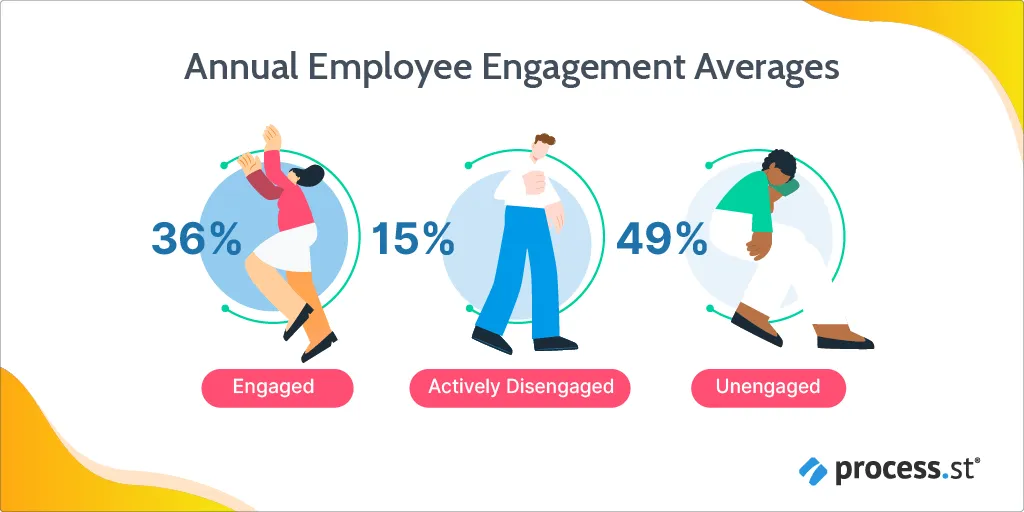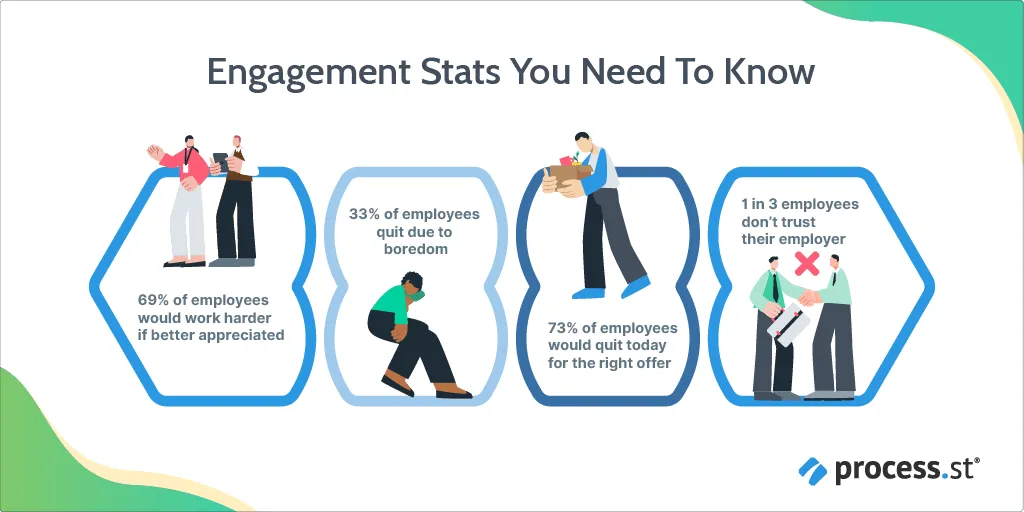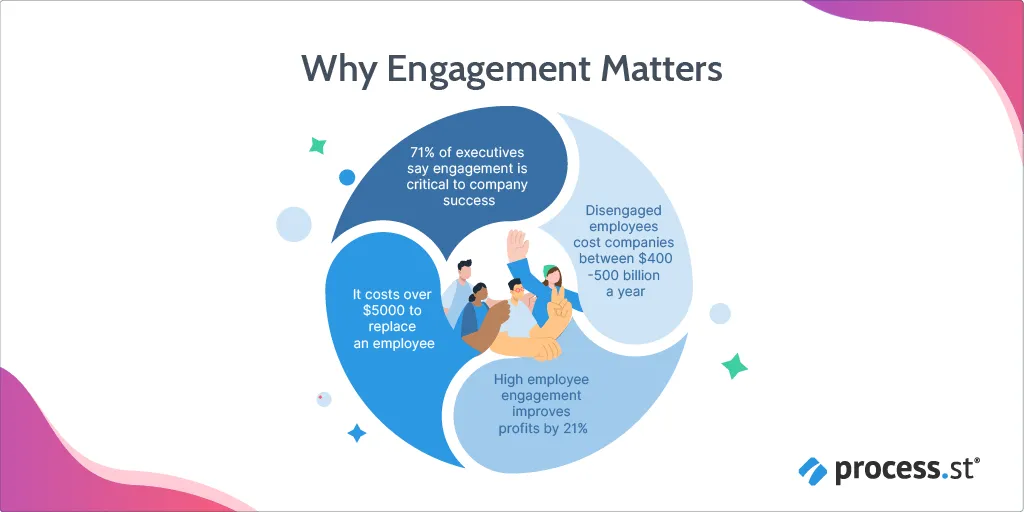Why You Need to Prioritize Your Unengaged Employees & How To Do It
Blog: The Process Street Blog

Actively engaged employees. Disengaged. Unengaged. Actively Disengaged. Non-Engaged.
The term “engagement” gets a lot of traction these days.
You see posts everywhere with topics like “What is Employee Engagement and Why Is It Important? A Complete Guide” or “Employee Engagement: How to Get a Happy, Productive Team.”
My favorite is “Employee Engagement & Motivation Policy: Why You Need One For Retention – Yesterday.”
The thing is, though, what do these terms actually mean – and how are they different from each other?
How do you tell if an employee is really engaged or just a high-performer? What about an employee who has low output versus one who’s actively disengaged?
And what’s this “unengaged” thing about?
Process Street has answers. This post will walk you through how to identify engagement, figure out the cause, and get your employees excited about their work again.
- Know your employee (dis)engagements
- Digging out the root of unengagement
- 5 strategies to re-engage your employee
- A final tip before we go
Know your employee (dis)engagements
36% of employees are actively engaged at work, according to Gallup. Only about 15% are actively disengaged. Good news, right?
Nope. That still leaves around 49% of employees who are just unengaged.
So what? you might ask. I need to worry about those actively disengaged employees first.
And you’d be wrong.
That unengaged 49% is likely to make up most of your annual churn rate. Why? Because they fly under the radar. Retention efforts aren’t made for unengaged employees because no one realizes they’re dissatisfied with their work.

You could be sitting right next to a disengaged employee while you read this and not even know.
Scary, right?
Fear not, dear reader. I’m here to help. First, let’s start with the basics.
The actively engaged employee
Employee engagement is often misinterpreted as employee happiness or satisfaction. It’s not.
Engagement means that the employee has made an emotional investment in their job and your company.
As Kevin Kruse (CEO and author) says in Forbes:
“This emotional commitment means […] [t]hey don’t work just for a paycheck, or just for the next promotion, but work on behalf of the organization’s goals. When employees care – when they are engaged – they use discretionary effort.” [emphasis original]
So a happy employee may not work hard and a satisfied employee might have no complaints; engaged employees are the ones who do that little bit extra. Their job isn’t “just a job.”
Note: Engagement shouldn’t be confused with overworking or work addiction. Rather than indicators of engagement, they’re the fast track to employee burnout and potentially serious health consequences.
The actively disengaged employee
Disengagement is vital in employees’ off-time, but in the workplace it’s fatal.
Chances are, though, if you have an actively disengaged employee, you’ll know it. Disengaged employees often act out or rebel against expectations and/or management. With an increase in negative or outright hostile peer interactions, it’s not unusual for team morale to drop as a result.
Some common behaviors are:
- Napping;
- Becoming withdrawn;
- Increased absenteeism;
- Decreased productivity.
While you’re disengaged employee might be a pain in your KPIs, don’t rush to punitive action. There’s often a reason behind your employee’s unhappiness and a simple solution to go with it.
Note: Among the top 5 causes of disengagement are lack of challenge, lack of motivation, and boredom.
The unengaged employee
Unengaged employees do exactly what they’re supposed to do – accurately and on time – but that’s all they do.
You can probably think of an employee – past or present – who you considered unambitious or complacent. It’s actually more likely that the employee was unengaged. Essentially, your typical unengaged employee is running totally on autopilot.
A few other indicators of unengagement are:
- Never/rarely participate in group discussions;
- Performs their responsibilities to the bare minimum;
- Doesn’t take initiative or exceed expectations;
- Ambivalent to growth or development opportunities;
- More interested in break time than work time.
Note: Don’t make assumptions because someone might be quiet in a meeting; there might be other reasons from simple insecurity to disabilities that actively impact participation. It’s always better to consider all the facts before rushing to a conclusion.
Digging out the root of unengagement

Stop viewing them as employees.
As a label, “employee” creates distance. Think about it. Who is The Employee?
Do you have a picture in your mind when you say that word? Is it someone you actually work with or is it simply a generic, anonymous placeholder attached to a rather clinical word?
Yeah, I am part of that generation all about wellness, work/life balance, and making a fuss over climate change. You’ll thank me later.
Let’s talk about people, specifically the people who are part of your company and why they lose emotional investment in it.
Ineffective management
Ineffective management is the leading cause of unengagement.
Let’s say you’re working away in your office doing a routine task – updating your employee handbook in Pages, for example.
Your manager comes in and says, “I need you to drop everything and build a learning and development program. It’s your top priority.”
An hour or so later, your manager comes back for an update on the employee handbook.
You haven’t finished the handbook because you prioritized the L&D program. The handbook is now the top priority; it needs to be done before tomorrow.
When you deliver the completed handbook, you get asked, “Where’s the L&D program?”
You try to explain but are cut off and are reprimanded for poor time management, inability to prioritize, and not being a team player.
Back at your desk, you get caught up in the next project. In the back of your mind – without even being aware of it – now lives the thought: Why am I working so hard if I’m just going to get yelled at anyway?
That, dear reader, is the first step on the road to unengagement.
Lack of appreciation
You likely say “thank you” more times a day than you even realize.
You say it to family, to friends, that random stranger who held open a door, and even your AI assistant who routinely messes up your appointments.
Any time anyone does a small kindness for you – whether human or AI – you reflexively thank them.
How often do you do that with the people you work with?
Do you show appreciation when they go above and beyond their responsibilities, or do you expect it?
Do you acknowledge their contributions to group meetings and brainstorming sessions?
Do you thank them for simply doing great work consistently?
Leadership is often very good at the big moments – work anniversaries, closing a big deal, onboarding a new client, etc. – but not so much the small ones. The thing is, those big moments don’t come around very often and those small ones matter a lot to your employees.
Anyone can close a deal or bring in a client. Everyone has an annual work anniversary and birthday. Most people get promoted at some point.
These events are special, sure, but they aren’t personal. That’s what creates unengaged employees: They don’t feel valued as individuals, so why should they be engaged?
Lack of purpose
Why am I even here?
At some point in our career history, all of us have asked exactly that question.
I remember the first time it hit me. I was in my office tallying sales, which essentially amounted to copying numbers from one piece of paper no one looked at to another piece of paper no one would look at and I had the thought: Why am I doing this?
I never found out, either, but after that moment I began noticing how much of my job was pure busywork. The more things I noticed, the less I cared about them.
What happened in the end? I jumped ship to one of our competitors who had been steadily wooing me and was very enthusiastic about putting my skills to use.
That’s just one example of how a lack of purpose can affect your teams. There’s also the question of the purpose of their work in the bigger picture.
Over or under-qualified
Under-qualified employees are essentially set up for failure. Without the right training and skills, they have no chance to perform their role well – or become engaged with it.
They may also feel resentment, insecurity, self-doubt, and low self-esteem – not to mention the lack of job security. If you’re consistently underperforming – even if that’s because you don’t have the right resources – it’s completely reasonable to think you won’t have a job for much longer.
Over-qualified employees are equally at risk for unengagement. They have a slightly different struggle in relation to their role, but it’s still a struggle. These people may complete their work too fast or feel like they aren’t being challenged enough.
In terms of morale, a person who’s over-qualified may simply “check out.” They’ll realize their full attention and effort aren’t required to do their job well, so run on autopilot most of the time.
Over-qualified employees also bring with them a unique hurdle: These individuals are probably used to being in charge – or at least possessing a certain level of authority. This will definitely lead to friction and frustration down the line – particularly if your over-qualified employee feels under-appreciated or under-utilized.
If you don’t keep an eye on how people are coping with their responsibilities, you’ll very quickly end up with an unengaged team. You’ll also miss potential opportunities available because of that team member’s skills and qualifications.
Boredom
Boredom is one of those things we just aren’t wired to cope with. Whether you love something or hate it, you’ll still engage with it to a certain extent. Boredom, on the other hand, is actually damaging.
Time slows down. You’d jump at the chance to clean every bathroom with a toothbrush if it gave you something to do.
In fact, your entire being is focused solely on getting away from whatever it is that’s boring. And if the thing boring you is your job? Well, do the math.
Someone who’s bored at work will very likely show up exactly when they’re supposed to, do exactly what they’re supposed to do, and go home exactly when they’re supposed to. They’re not going to scream it from the rooftops that they’re bored, but you’re probably going to see them in the breakroom quite a bit.
5 strategies to re-engage your employee

Lead, don’t manage
Companies hire ineffective managers 82% of the time.
Why? Not all managers are leaders, and not all can become leaders. When it comes to filling a leadership role, you can’t just slot in whoever the best salesperson is or the one who’s been at the company the longest.
Good leaders need to understand the people working with them. They need to be able to build trust and communicate, maintain a positive company culture, and ensure their teams feel supported and listened to.
These are not easy skills to have. In fact, Gallup says only about 10% of the population have the skill set required to be a good leader. There’s a further 20% that could function as a good leader with ongoing training and development in areas such as empathy, communication, team-building, and so on.
Those are some not-so-great numbers. The good news, though, is that you probably do have the leadership talent you need already in your company – it’s just not the one currently in that role.
In your recruitment and hiring practices, be on the lookout for candidates who have those leadership qualities that could be cultivated down the line. Use regular talent audits, assessments, and analytics to identify current individuals who have leadership potential.
Yes, your employees and department leaders need to understand and achieve company goals, but the job requires more than that so you need to look for more than that.
A manager may have great hard skills; a leader needs exceptional soft skills.
Create an atmosphere of appreciation
Bottom line: People need to feel appreciated.
Here at Process Street, we have a pretty neat system. It started out as something we did at the start of departmental meetings and then expanded to a company-wide Slack channel.
The great thing about kudos is that it isn’t just leaders acknowledging their own teams: Everyone gets in on the game.
Team members can recognize each other. Cross-departmental colleagues can thank each other. Leaders can shout out to other teams in the company. Team members can even show appreciation for their leaders (yes, leadership needs appreciation sometimes, too).
This is great for a few reasons:
- An environment of appreciation;
- Public recognition;
- Increased morale and culture;
- It’s fun!
Drive motivation through purpose
We have a keyword research workflow we have to do for every blog post. I hate it.
But I understand why we do it.
We need to use the right keywords for the topics we write about. Keyword research has a purpose and that means – even if I don’t enjoy it – I know exactly why I’m doing it.
It’s a little like household chores: No one really likes taking out the trash or vacuuming the carpet. We do like the result, though, so the benefit outweighs the drawback.
Providing a sense of purpose is probably the easiest and most immediate way you can address unengaged employees. Just give them a reason.
Qualifications aren’t always black or white
During your recruitment stage, make sure each candidate has the skills, experience, and qualifications to perform the job. If they don’t, consider whether or not they have the capacity to develop them and whether or not you have the resources to get them there.
If they’re overqualified for the position, find out what their motivation is. It’s possible they decided to change industries or perhaps want less stress or responsibility. They could want a more flexible schedule or fewer demands to spend more time at home.
If their reason is simply that they need a job right now, there is an almost certain guarantee that you’re setting them up for unengagement, if not outright disengagement.
Only you can prevent employee boredom
The solution to boredom is not more busywork.
If boredom is a result of not enough work, handing your employee a bunch of menial tasks to do isn’t going to make them any happier – or any less bored. If anything, it’ll all encourage them to not speak up about it.
Plus, no one wants to do more work for nothing.
Create an incentive program instead. Use gift cards, extra time off, or other small rewards to acknowledge their extra effort and motivate them. You can make this even more effective by pre-planning tasks appropriate to that employee’s skill level.
These don’t have to be high-priority tasks, but you don’t want to ask your top engineer to stuff envelopes just because they don’t have enough to do.
Boredom may also be a result of the work being either too challenging or not challenging enough. This is sometimes related to being over or under-qualified, but not always. It could be the result of a minor skill such as reading faster than their colleagues or parsing numbers more easily.
Implicit knowledge isn’t often found on a resumé so stay informed about the additional skills your employees bring to the table.
It’s also worth checking whether or not the employee is in the right position. They could be bored because they have no interest in what they’re doing. There could be another team or department they’d be happier or more motivated in. They might even be part of that rare 10% with natural leadership skills.
It could even be that they have no interest in what they’re doing and would be happier on a different team or in another department. This could also be an opportunity to identify latent talents or assess their leadership skills.
A final tip before we go
The best way to handle unengagement is communication.
Open communication channels increase trust, collaboration, commitment, and loyalty. It helps people feel valued and cared for – and increases the value they place on their colleagues.
It’ll also help you identify – and address – unengaged employees. As I said in the beginning, you could be sitting right next to someone who’s unengaged and not have a clue.
If you don’t communicate, you’ll never know, either.
How have you dealt with unengaged employees in your teams? Share any tips we might have left out in the comments below!
The post Blog first appeared on Process Street | Checklist, Workflow and SOP Software.
